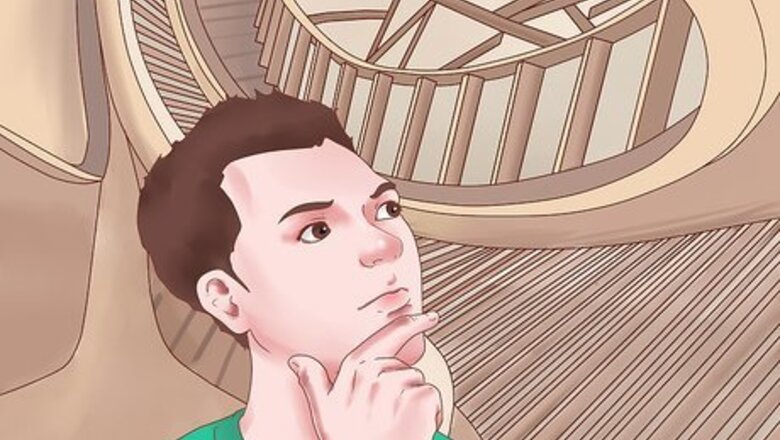
views
X
Research source
You can learn to build your confidence, get on your first coaster, and control your emotions along the way. You might even have fun. See Step 1 for more information.
Building Your Confidence
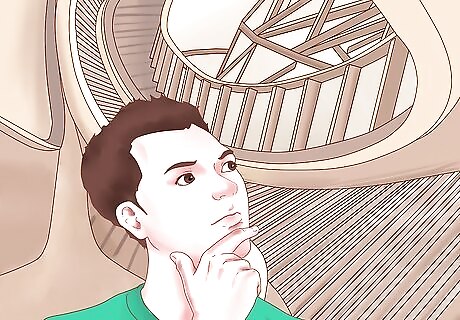
Learn what to expect. It's a good idea to learn a little about roller coasters before you ride your first ones. Specific parks will usually rank the roller coasters on intensity, so you can learn more about the particular roller coasters you're going to visit when you get there and get the park map, or you can check out the specific coasters online. Wooden roller coasters are the oldest and most classic coasters. Usually operated on chain-lifts, they'll go very fast, but never go upside down or in complicated loops, for the most part. Steel-track roller coasters are much more complex, featuring lots of twists and turns, often upside down. But some steel coasters are good because they will have more turns and not as many drops. They will also be less rickety and smoother than wooden ones. There are some small steel coasters which are great for first time as wooden coasters are very bumpy. If you're scared of the big drops, look for a roller coaster with a curved drop instead of a straight drop, so you'll get a gradual ride and won't feel as if you're plunging. You can also choose a launched ride, which accelerates you at high speeds instead of dropping you off of a large hill, though these are just as intense in some cases. It may seem silly, but most kid rides allow anyone to ride, and can be a great start. Try not to find out specific things like how tall the coaster is, how fast it goes, and other specific "scary" numbers. It is a good idea, though, to check out the twists and turns so you can brace your body and know what to expect from the ride and avoid rides that do stuff you're intimidated by. Find these things out after you ride so you can tell others and be proud of yourself.
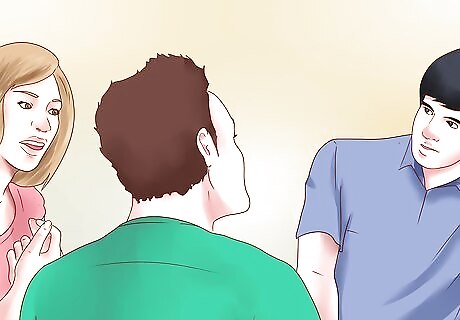
Talk to other people about their experiences. Millions of people ride roller coasters every year and have a blast doing it. There's little to fear from the roller coaster, and lots of fun to be had. Talking about it with enthusiasts is a great way to get interested and excited in roller coasters for yourself. Also talk to people who were scared but now love them as it will help you see what you should ride. Talk to family and friends, as well as park employees at the gate who enjoy roller coasters. Ask them what rides at the park are the smoothest or the tamest, and which ones to avoid. Another good idea is to ask people what their first roller coaster experience was. You can get a good idea of what to avoid on your first ride. Read online about the good coasters at the park you're going to visit. Try to watch YouTube videos on anything you think you may go on to see if they seem tame enough for you.
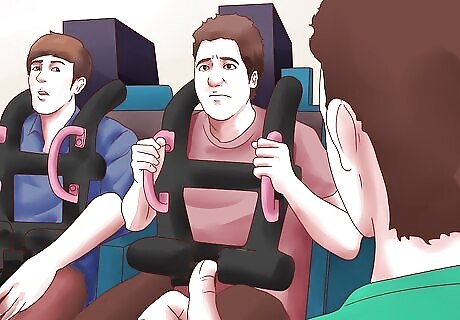
Understand that roller coasters are supposed to be scary. If you're feeling scared by the idea of a 12-story drop going 60 mph (97 km/h), that's perfectly normal. That means the theme park is doing its job! Roller coasters are made to be scary to give riders fun thrills and chills, but they aren't actually dangerous as long as you follow the safety precautions and listen to instructions. A coaster is thoroughly tested before being cleared for public use, and all the rides receive regular maintenance to keep them in top working order. You needn't fear malfunction at professional parks. Some injuries are reported each year from riding a roller coaster, but the vast majority of those injuries are the result of rider error and rule-breaking. If you listen to instructions and stay seated, you'll be fine. Statistically-speaking, you've run a greater risk of injury by driving to the theme park than riding the roller coaster. The chance of fatal injury on a roller coaster is 1 in 1.5 billion.
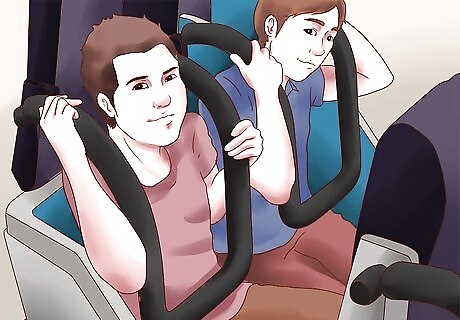
Go with friends. Riding roller coasters should be fun, and it'll always be a lot easier with friends to cheer you on, scream together, and support each other through it. Some people find it more comfortable with a person who is also scared so you both can scream your guts out, and you won't feel left out. Others like going with someone who has already been on the coaster, and could reassure you'll be okay. The people in your environment can have a lot of influence on you. So be with supportive people. Don't go with people who will push you to do things you don't want to do. When you find your limit, don't ride anything bigger unless you are ready to push your limits. It doesn't matter what everyone thinks of you if you've found your comfort zone and want to stay in it. Don't let anybody try to push you around or pressure you into riding rides you aren't comfortable with yet.
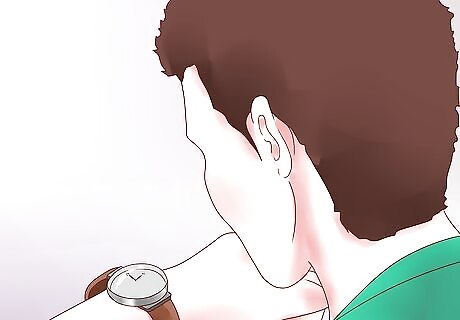
Look at your watch. The average roller coaster is usually shorter than a television commercial. In some cases, you'll wait in line for 2,000% more time than you'll be on the ride. The drops, although very big, will be over in the time it takes you to take a breath. Try to remember that the whole thing, for better or worse, will be over extremely quickly. The wait is the big source of fear and anticipation, and the ride is the fun part.

Read the regulations and restrictions before getting in line. Before you wait in line, make sure you meet the height requirements listed at the start of the ride and that you're not physically unfit to ride. Typically, people with heart disorders, people who are pregnant, and people with other physical disabilities are not permitted to ride roller coasters.
Riding Your First Coaster
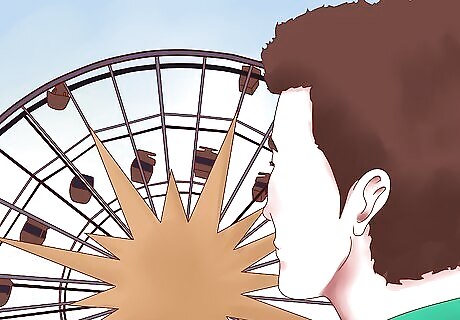
Start small. It's probably not a good idea to jump straight onto Kingda Ka or Smiler. Older wooden coasters with small-medium drops and no loops are usually a good bet for first-timers and those who want to try out coasters without getting scared. Spend time looking around the park, checking out a couple of roller coasters to find the less-scary ones. Ride some other exciting rides first to get your adrenaline up and to get used to the sensations. While roller coasters might seem like a big deal, they're not usually much more scary than other types of rides. If you can handle the Scrambler, you've got a roller coaster on lockdown.
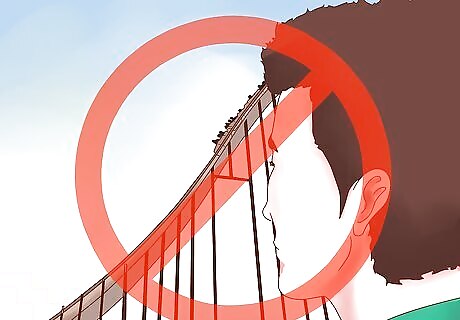
Don't watch. As you're walking around the park, as you're waiting in line, as you're getting ready to get on, Try to resist the urge to look up at the big drop or the scariest part of the ride. Focus on talking to your friends and distracting yourself from what's about to happen. There's no sense in getting worked up looking at the big drops now when you're on the ground. Think about other things and keep your mind off it. When you're waiting in line, focus on looking at all the people getting off the ride at the end, not on the scary drops and loops. They all look, probably, like they had a blast, and they all came out just fine. So will you.
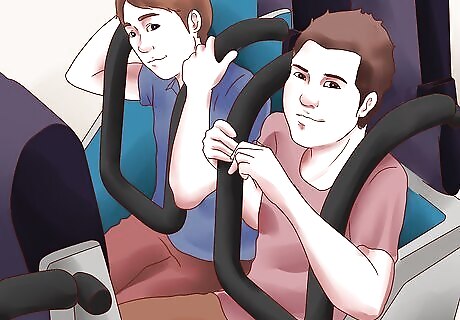
Sit somewhere in the middle. If it is your first time on a pretty scary one, the best place to sit is in the middle, so you can focus on the back of the seat in front of you and don't have to worry too much about what's coming, but you can still see if you want to. The middle offers the gentlest place in the ride. Alternatively, you might want to sit in the front so you can see, if it makes you feel better. Not knowing what's coming is scarier for some people. Don't sit in the back-most seats, which exert stronger g-forces during the sharp turns and the drops. The ride feels more intense when you're sitting near the back of the cars.
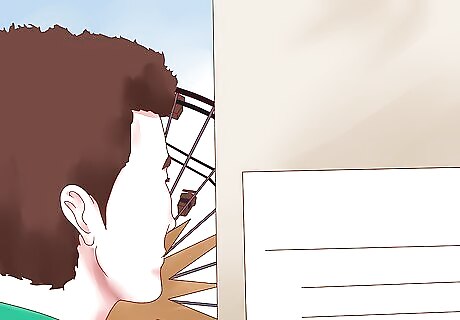
Follow the instructions of the park employees and the ride guidelines. As you approach your seat and sit down in the car, listen closely to verbal instructions and follow directions from the employees. Different roller coasters use different types of safety harnesses, so you'll have to listen closely to make sure you get into them correctly. When you sit in your seat, make sure it feels comfortable and that the safety harness comes down across your lap snugly. If you can't reach it, or if the harness is especially complicated, wait for the park helper's instructions. If you lock it in yourself, they'll still come around and check to make sure everything is solid. When you've got your harness on, sit back and relax. Stow any glasses, or loose jewelry that you might have on in your pockets, and take some deep breaths. You'll be fine!
Getting Through It
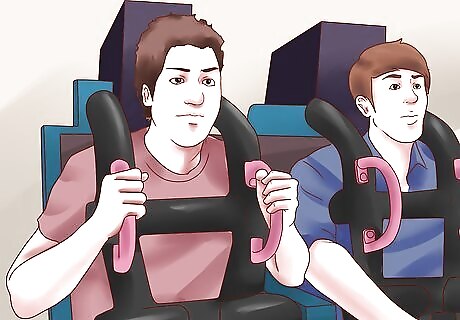
Look straight ahead. Keep your head secure and back against the seat rest in your chair, and Try to focus on the track in front of you, or the back of the seat front in front of you. Don't look down or focus on things to the side, which can emphasize the speed at which you're traveling and increase any feelings of disorientation and nausea. Don't look down, in other words. This is especially helpful if you're going on a loop. Look straight ahead and focus on the track and you'll only feel a slight feeling of weightlessness that should actually be pretty pleasant and should pass in a moment or two. Resist the urge to close your eyes. Inexperienced riders often think that closing your eyes will help make it less scary and that you'll feel better, but closing your eyes will lead to feelings of disorientation and can make you feel nauseated. Focus on something stationary and don't close your eyes.
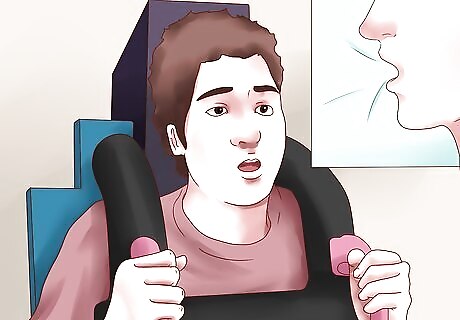
Breathe deeply. Don't hold your breath on roller coasters or you might become light-headed and everything will be worse. As you're nearing the big drop, take deep breaths and Try to focus on your breathing instead of other things. This can help to center you and calm you down, focusing on a little thing. Just breathe in and breathe out. It'll be fun. To help you focus, count your breaths as you take them. Breathe in deeply for a count for four, then tense your muscles for a count of three, then blow your breath out for a count of four. Continue cycling in this way to calm your nerves.
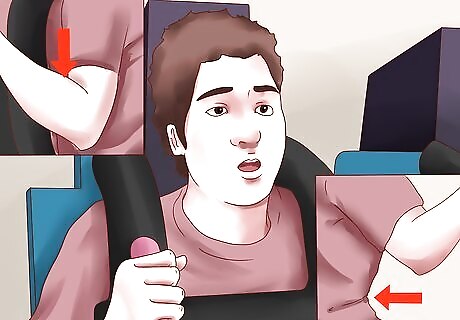
Flex your stomach and your arm muscles. At some point in the ride, you'll start to feel some butterflies, probably sooner rather than later. That's part of the fun of the roller coaster, but it can be a little overwhelming for some people. To ease it slightly, you can tense up your stomach muscles and your arms by grasping the hand-holds provided for you on the harness and the chair, to Try to keep calm. On a roller coaster, adrenaline will be released in large amounts, triggering your fight or flight impulses. Your blood pressure will rise, you'll sweat some, and your breathing will quicken. Your vision should also sharpen and you'll be ready for action. You can alleviate this slightly by tensing your muscles, communicating to your body that it can chill out a little.
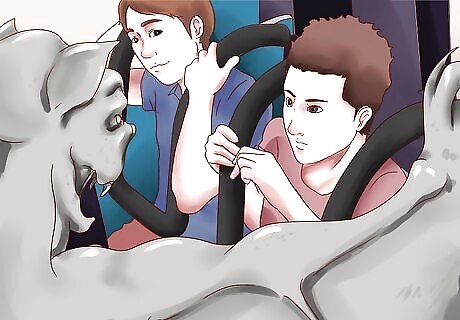
Ignore the spooky decorations. Lots of rides will up the scare-factor by including all sorts of scary paint and dark lights and little animatronic animals or goblins along the side of the ride to scare you. If you're mostly scared of the physical sensations, these can serve to totally throw you off and make the whole thing a lot worse, so you're better off ignoring them as much as possible. If things are shooting off or moving, just stare straight ahead and don't worry about it. Keep breathing. Alternatively, some rides with a story-line can help to distract you. If you get caught up in it, just stay focused on the fun of the story and stop worrying about the ride being scary.
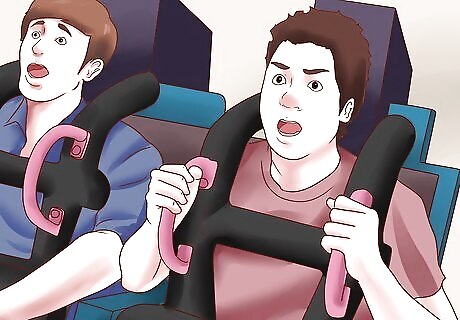
Yell loudly! You definitely won't be the only one, and the train is usually noisy anyway with people cracking jokes and yelling back and forth. Instead of just being quiet with fear, screaming can actually make the ride more fun. You can also mix your screaming with some woo hoos, yahoos, whees, or whoopies! Screaming can take away the scariness and make you want to laugh.
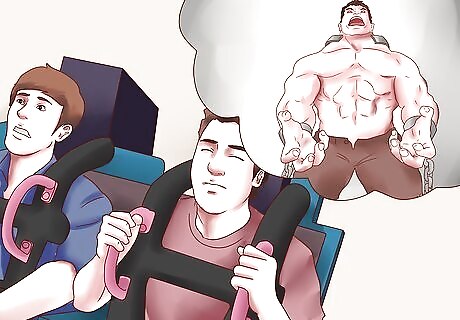
Use your imagination to your advantage. If you're still freaking out, try to use your mind to go elsewhere. Imagine that you're flying somewhere on a ship, or that you're being whisked away to Batman's lair, or that you're the one doing the driving. Anything to take your mind momentarily off the dips and the drops can help to distract you from what's happening and make the whole thing go faster. Get pumped up and be a beast. Pretend that you're an unleashed Kraken or some kind of dragon on the high rides. If you have the feeling of power, you will feel less tension and your mind will think of something else. Some riders like to have a mantra, or a little bit of a song that they use to chant during the ride. Keep the melody to "Reflection (Mulan, 1998)" or "Poker Face (Lady Gaga)" in mind and just focus on the words instead of how you're feeling. Or just recite something simple, like, "I'm gonna be fine, I'm gonna be fine." There are different degrees of fear. Recognize whether it is an imaginary or an actual fear where something needs to be done immediately at the moment. Try to have a deep inner trust that you know better than the fear.
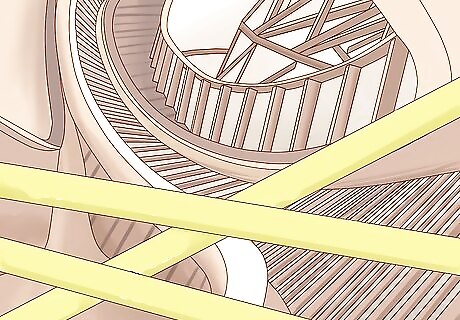
Always use your own judgment. If a ride doesn't seem safe to you, or if the employees seem unconcerned about safety, or if you've heard about previous incidents or safety concerns, don't ride that roller coaster, especially if it's going to fill you with anxiety. Most rides at large parks are expensive pieces of machinery that are well maintained and tested regularly. A roller coaster's track is typically inspected each day before the ride is run for the first time, and will be closed down if a problem is detected. If a ride has been closed frequently over the past couple of weeks, it might be best to avoid it. The chances of an undetected problem are slight, but it might make you feel better to skip the ride.




















Comments
0 comment